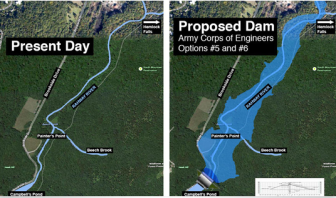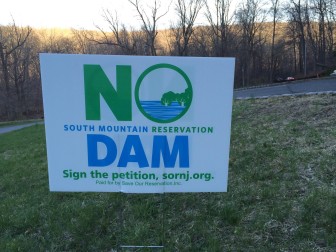7/22: This article has been updated with a quote from Millburn Mayor Robert Tillotson.
7/18: This article has been updated with a quote from Essex County Executive Joseph N. DiVincenzo, Jr.
7/17, 6:30 p.m.: This article has been updated with quotes from Maplewood Mayor Vic DeLuca and South Orange Trustee Walter Clarke.
It looks as though there will be no dam, after all.
Amid wide-spread opposition from a coalition of elected officials, community leaders, environmentalists and residents — including a grassroots campaign that saw lawns throughout South Orange, Maplewood and Millburn dotted with “No Dam” signs — the New Jersey Department of Environmental Protection (DEP) recommended Thursday against building a dam in South Mountain Reservation.
In a letter to the US Army Corps of Engineers, the DEP advised against the plan for the 75-foot high, 810-foot wide dam across the Rahway River in the southern section of the reservation, and instead gave the nod to two other options for flood mitigation.
“The DEP has taken dam off the table,” said Fred Profeta, former Maplewood Mayor and chair of Save Our Reservation, a group that opposed the dam. “As a result…Save Our Reservation has essentially achieved its objective. We look forward to seeing that the flood mitigation efforts are actually funded and implemented, because it is important the people downriver of the Rahway receive the benefit of flood mitigation.”
The dam, one of ten alternatives that emerged from the Army Corps’ Rahway River Basin Flood Risk Management Feasibility Study, was intended to help abate destructive flooding seen in Cranford and other downriver towns.
The two alternatives suggested for further study are channel improvements with modification to the Orange Reservoir outlet pipes; and ten-year non-structural measures.
The recommendations came in a letter from the DEP’s Manager of Dam Safety and Flood Control, John H. Moyle, to Paul Tumminello of the Army Corps of Engineers.
Save Our Reservation, in cooperation with the South Mountain Conservancy, local environmentalists and other organizations, had pushed for alternatives to the problems of flooding along the Rahway River watershed, saying construction of the dam and the associated 110-acre dry detention basin would “irreparably damage” the century-old reservation.
Many officials expressed opposition to the dam, including Congressman Donald Payne, Jr., NJ Assemblywoman Mila Jasey and Assemblyman John McKeon, Essex County Executive Joseph DiVincenzo, as well as the Townships of South Orange Village and Maplewood.
In addition, nearly 6,000 residents from towns around the reservation signed an on-line petition opposed to the dam and suggesting alternatives that would cost less, protect flood-prone towns and preserve the reservation.
“Essex County South Mountain Reservation is magnificent natural resource that would have been destroyed if the dam and retention basin proposed by the Army Corps of Engineers had been built,” said DiVincenzo in an email. “We are pleased that our protest and the campaign organized by Save Our Reservation, the South Mountain Conservancy and the Rahway Alternative Flood Solutions Alliance convinced the Corps to abandon this idea and investigate other alternatives that are more financially feasible and environmentally friendly.”
Option 4 involves constructing two 30″ outlet valves in the existing Orange Reservoir dam in the reservation and doing channel work in Cranford, which would deepen the existing channel and remove two dams there which back up water. The valves in the Orange dam would be used to release water slowly in advance of a major storm, letting the reservoir fill back up during and after the storm.
Option 7a involves waterproofing some structures in Cranford, raising some up, and taking down two, said Profeta, who said that option is not popular with Cranford officials and residents.
“The decision by the DEP weighed the benefits and costs of ten alternatives to implement flood mitigation for communities from Millburn to Rahway,” said Dan Aschenbach, former Mayor of Cranford and coordinator of the Mayors Council Rahway River Watershed Flood Control, in an email.
“Alternative 4 had the best benefits over cost amongst the alternatives reviewed, meaning at peak storm conditions the river water elevation would be significantly lower if the alternative got implemented,” Aschenbach said.
He continued, “The Mayors Council is pleased that the reservation can be protected yet meaningful flood protection can still be achieved. We hope all those who expressed concern about the dam now can support the alternative 4 and also to improve stormwater management including development of non-structural solutions such as rain gardens.”
“This is a win – win,” said South Orange Trustee Walter Clarke. “People in our area benefit because we will be able to continue to enjoy the reservation in its present form. People downstream will benefit because alternatives 4 and 7A have a better cost benefit ratio and are therefore more likely to bring some flood mitigation their way.”
Maplewood Mayor Vic DeLuca, who serves on the Mayors Council, called the decision “great” and “a good [example] of elected leaders and the grassroots coming together and forcing the issue and moving to a better solution.
There’s no way a dam is going to be built now,” DeLuca said.
DeLuca said Maplewood first indicated opposition and a desire to seek alternatives to the dam in February. In April, the Mayors Council met and agreed to throw its support behind option 4, said DeLuca, calling that meeting a “huge win” that solidified the fact that the dam was not only financially unfeasible but politically unpopular.
“The dam is dead in the water so let’s move on,” Millburn Mayor Robert Tillotson recalled saying at the April meeting.
The next step is for the Army Corps to agree to the recommendation and to finalize the study before it is sent to Congress for funding, said Aschenbach.
“Our cherished river valley will not be destroyed,” said Profeta.



